 |
||
|
||
| ||
Today we continue dealing with the most powerful 3D accelerators produced by the former Noname companies. The beginning is here. In the Palit card review I analyzed the situation concerning such companies in detail, that is why this subject won't be touched upon anymore. Just remember that Joytech, which is known mostly for its Apollo Graphics trade mark, is an experienced company, and till recently all its production was based on OEM orders. And only a year ago the company decided to enter the market under its own trade mark and promote its products itself. The company produces cards based on processors from different manufacturers - ATI, SIS, NVIDIA, STM/PowerVR. We already examined some cards in our lab and saw that Joytech wasn't used to follow the reference design. However, there are exceptions. And the today's card is one of them. Almost all cards based on the GeForce4 Ti which we managed to test are copies of the reference sample from NVIDIA. So is the Joytech's card. As I mentioned before, products of the High-End class but from less known companies differ primarily in prices. At present the market gets more and more copies of the reference cards, that is why they have few differences. Well, why to pay more if you can buy the same thing at a lower price? We discussed it already in the Palit Daytona GeForce4 Ti 4600 review. And now before we turn to the card in question take a look at the list of reviews of the GeForce4 Ti cards published on our site. Theoretical materials and reviews of video cards which concern functional properties of the NVIDIA GeForce4 Ti GPU
Note that apart from examining peculiarities of the Joytech Apollo Bloody Monster II GeForce4 Ti 4600 we will continue testing operation of anisotropic filtering on several stands. Card
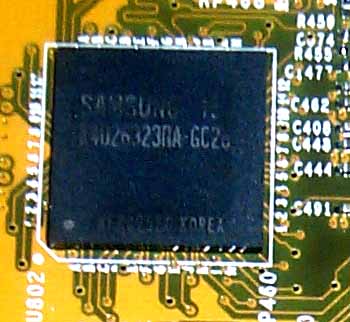 The card has an AGP x2/x4 interface, 128 MBytes DDR SDRAM located in 8 chips on both sides of the PCB. The Samsung 2.8ns memory chips correspond to 357 (714) MHz. The memory works as 325 (650) MHz. The chip works at rated 300 MHz. The card follows the reference design entirely. Many cards based on the GeForce4 Ti differ almost only in coolers. This cooler differs much from the NVIDIA recommended one, but at the same time it is very simple. Note that there is another version of this card with a different cooling device (the central cooler is a copy of the NVIDIA's reference one, the heatsinks on the memory are the same as on the Chaintech and Gainward cards). 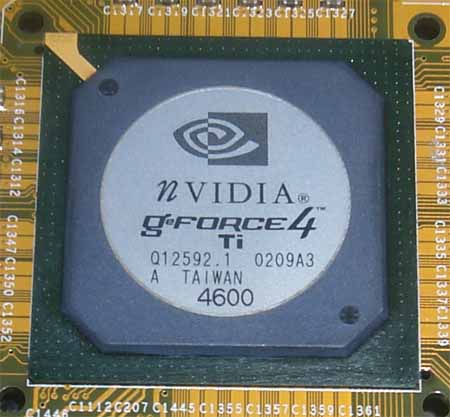 And here is the GPU (A3 revision). This is a newer revision which has the official marking. 
 The memory chips have ordinary plate-type heatsinks. According to the reference design of such cards it's not necessary to cool down memory, that is why installation of heatsinks on the memory modules is an initiative of the developers. The Apollo Bloody Monster II GeForce4 Ti 4600 card has Philips 7108 codec which controls the VIVO function (it was described in the articles listed above). Remember that such long cards as GeForce4 Ti 4400/4600, which have a lot of capacitors in their tail-part, can be incompatible with some mainboards, for example, with EPoX 8KHA+. For details see the MSI GF4Ti4600 review. Besides, there can be problems with i815E mainboards, for example, with the Chaintech 6OJV2. See the Creative 3D Blaster 4 Titanium 4400 review for details. Apart from VIVO, the GeForce4 Ti Apollo Bloody Monster II GeForce4 Ti 4600 is equipped with VGA and DVI connectors. The dual-monitor support was also spoken about earlier. The card ships in the blood-red retail package which includes:
OverclockingThe card comes with 27.50/Win9x and 27.50/WinXP drivers. The card works stably at 320/375 (750) MHz. The result is very good, but taking into account that the card uses the chip of the A3 stepping which overclocks easier, we can criticize the cooler. Note:
 Test system and driversHere we examine how the accelerator's performance depends on a CPU frequency (and on a platform), that is why we used several test stands:
The test system was coupled with ViewSonic P810 (21") and ViewSonic P817 (21") monitors. In the tests we used NVIDIA's drivers of v28.32. VSync was off, S3TC was off. For the comparative analyses we used the following cards:
Test resultsThe 2D quality is excellent, no problems up to 1600x1200x85 Hz. For estimation of 3D quality we used:
The test was carried out in a 32-bit color mode with the anisotropic filtering enabled up to Level 8 for the GeForce4 and up to 16x degree for the RADEON 8500.Note that these tests continue the examination of the anisotropy operation on different platforms. The beginning can be found in the Palit Daytona GeForce4 Ti 4600 review, where we saw that the performance drop is very great when the anisotropy gets enabled! 3D Mark2001 SEGame3 Low Details1024x768
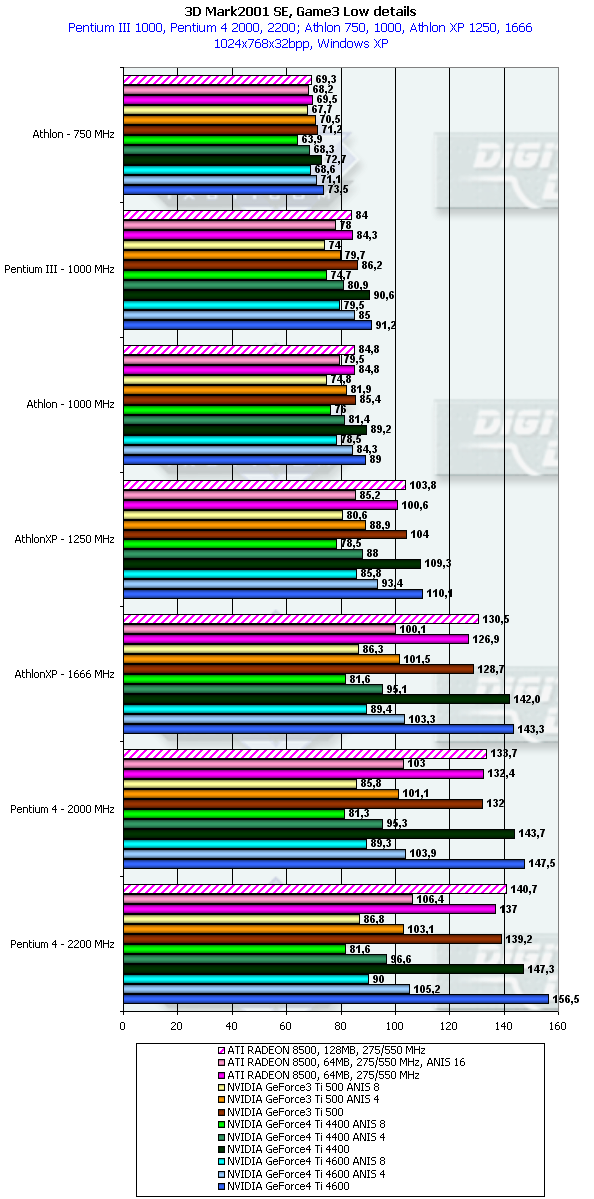 Again we see that the speed of the Ti 4600 drops considerably with the anisotropy enabled, and the card starts losing to the RADEON 8500. I have found no differences in realization of this function in this test. 1280x1024
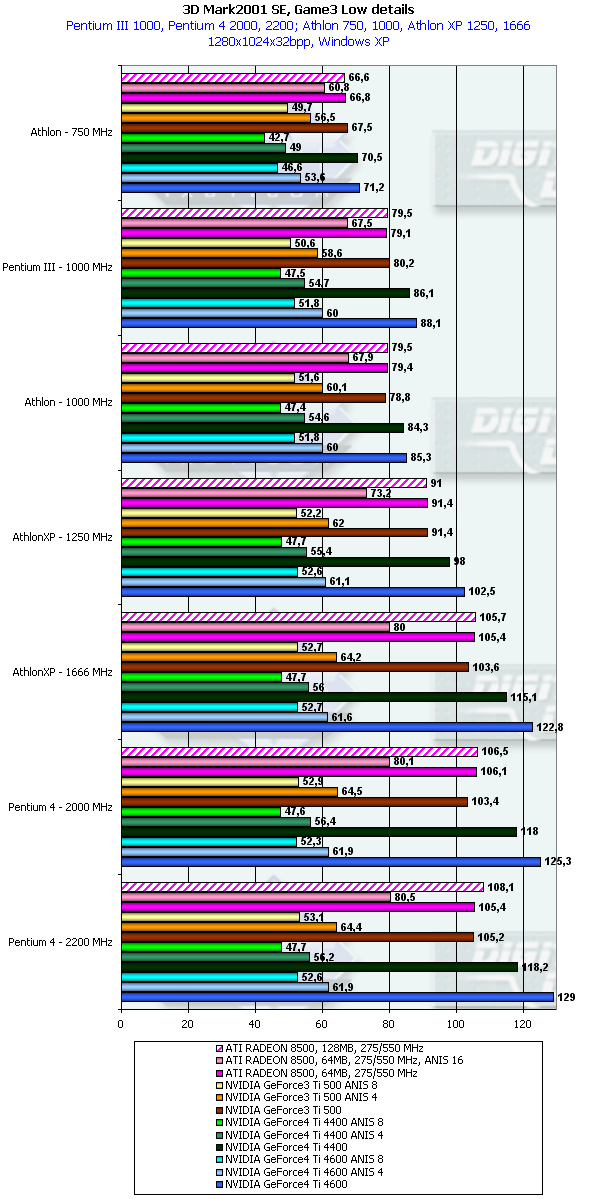 The situation is even worse for the Ti 4600. 1600x1200
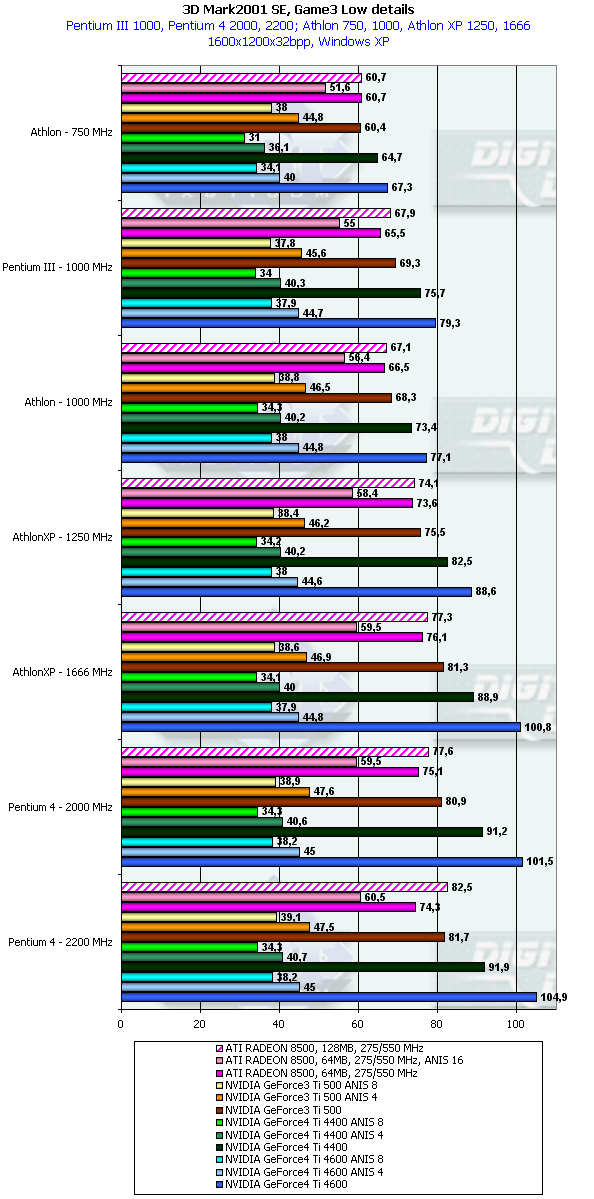 Even the junior CPUs and less powerful platforms do not help, and the performance of the Ti 4600 at Level8 is equal to Ti 500. As I mentioned already, NVIDIA have something wrong with the anisotropic filtering - it should be improved in case of the GeForce4 Ti. But it's wrong to compare directly both ways of anisotropy realization - of NVIDIA and ATI. I don't give any screenshots of this test because it's impossible to find any differences between quality obtained on the GeForce4 Ti and RADEON 8500. Game41024x768
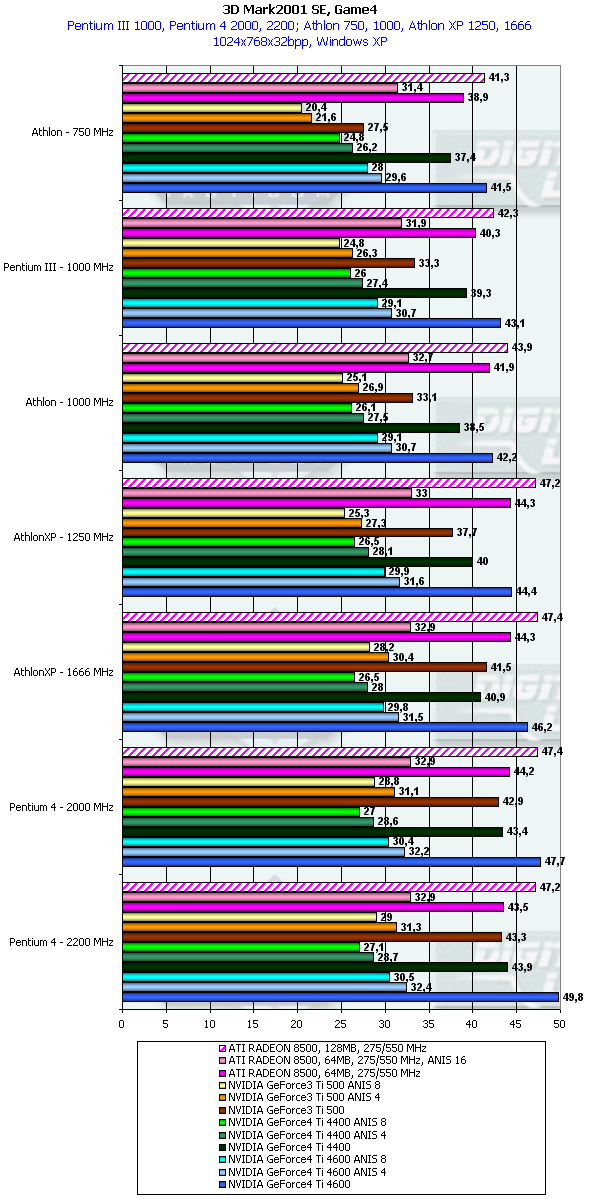 The situation is unpleasant, the cost of quality is too high. 1280x1024
 1600x1200
 And only here the RADEON 8500 yields to the Ti 4600 when the anisotropy is enabled. No examples either because there is no difference between the RADEON 8500 and GeForce4 Ti in quality. ConclusionWe finished examination of the awful performance drop of the GeForce4 Ti working with the activated anisotropy. However, I will return to it when new driver version appear (I just want to believe that it's not the chip to blame). It's sad to see such things with the card priced at $400... But there are a lot of users out there who know nothing about such filterings, and for them the GeForce4 Ti 4600 remains the fastest card for the spring 2002. Like the Palit's card, the Joytech's model is a successful solution as a copy of the reference-card at a lower price (some $310 for the Joytech Apollo Bloody Monster II GeForce4 Ti 4600 in May 2002). Note that the price covers the VIVO (Video-In Video-Out). For more complete characteristics of video cards of this and other classes see our 3Digest. Highs:
Lows:
Write a comment below. No registration needed!
|
Platform · Video · Multimedia · Mobile · Other || About us & Privacy policy · Twitter · Facebook Copyright © Byrds Research & Publishing, Ltd., 1997–2011. All rights reserved. |